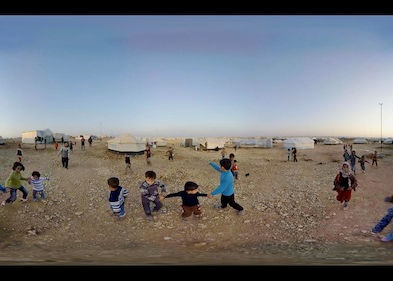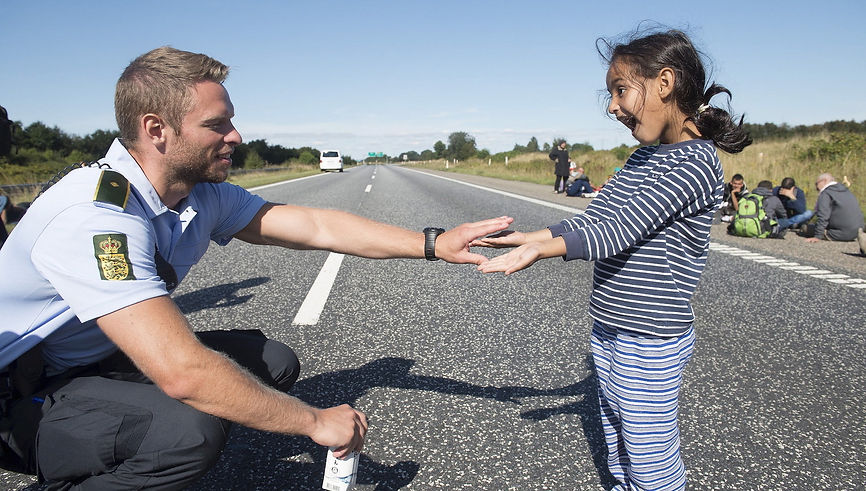
Stanford University's Virtual Human Interaction Lab studies whether virtual reality can actually, scientifically, increase empathy. Since 2001, the lab has performed roughly a dozen studies using the technique of embodiment, where subjects wear body-movement sensors and headsets and watching their avatars as members of another gender or race.
The majority of their studies have shown that virtual reality can cause a moderate increase in empathy.
The method of embodiment this lab uses, where you feel as if you are actually within the virtual environment, is thought to be more powerful than the embodiment found in experiencing virtual reality films, such as Clouds Over Sidra, where one is dropped into a virtual environment. The image to the left is a scene from Clouds Over Sidra; this is typical of what one would witness when experiencing a virtual reality film like Clouds Over Sidra.
The Experiment
-
-
Conducted by: Gehlbach, H., Marietta, G., King, A., Karutz, C., Bailenson, J.N. & Dede, C.
-
Published: Computers in Human Behavior, 52, 523-532.
-
"Many Ways to Walk a Mile in Another's Moccasins: Type of Social Perspective Taking and its Effect on Negotiation Outcomes" explored the possibly of resolving inter-group conflict using virtual reality and 'social perspective taking'. Social perspective taking is a process where one individual is able to discern the thoughts, feelings, and motivations of another individual or group (the 'target'). Social perspective taking depends on a variety of factors from the degree of knowledge known (or provided) about the 'target' to the manner in which information was learned about the target. Information could be learned passively, by being given the information, or actively, where one has to discover the information themselves. This study focused on which type of social perspective taking was the most beneficial for influencing outcomes.
Significance: This particular experiment and its results are significant in that they can be applied to real world situtions and potentially provide a framework to assist in resolving conflict between different groups. This experiment also suggests the benefits of using virtual reality to aid in resolving conflict. For example, the government could use virtual reality experiences to train diplomats for negotiating with other cultures; taking on a first person perspective could increase the chance of reaching a compromise as one would better understand why the other side was unlikely to make concessions in certain areas. The United Nations has already started to use virtual reality to help diplomats understand the feelings and desires of refugees and other vulnerable populations.
How it worked: the study centered around the premise that there was a conflict between the business development of a golf course owner and conservation efforts of a park ranger. First, users took the role of a golf course owner from a first person perspective and spent time negotiating about six unique issues with different characters and completing tasks, such as reviewing cost estimates of building a new clubhouse.
Users were then randomly assigned to three different groups: 1) No learning (participants learned nothing about the park ranger's perspective or personal priorities and were instructed to take on the park ranger's point of view by "thinking about the ranger's perspective").
2) Informational learning (participants were given basic information about the park ranger's personal priorities to read and were instructed to take on the park ranger's point of view by "thinking about the ranger's perspective").
3) Experiential Learning: Rich Mental Simulation (participants 'experienced' the park ranger's perspective by reading a very detailed script that mirrored the 'virtual shoes' condition, shown below).
4) Experiential Learning: Virtual Shoes (participants experienced the park ranger's perspective by becoming the park ranger in a first person persceptive & walking around the ranger's world, meeting the ranger's constituents, and learning about various issues).
Conclusion: The more the participant learned about the target (the park ranger), the more positive the relationships produced and the greater the concessions during negotiation. When nothing was learned about the target, participants feared the worst and became more competitive which resulted in less concessions during negotiation. Experiencing a first person perspective instead of passively learning also lead to a more positive relationship.
Then, all participants reverted back to having the golf course owner's first person perspective. The golf course owner, whose ultimate goal was to earn a large commission, then had to negotiate with the park ranger.
Hypothesis: The more information a participant received about the park ranger, the more positive the relationship; the participant, as the golf course owner, would also be more willing to make concessions during the negotiation with the park ranger. Secondly, it was expected that for groups that did receive information about the ranger, perceiving this information actively and experientially from the perspective of the park ranger would help participants view the information in a more favorable light. Lastly, it was expected that the participants who experienced the park ranger's perspective from a first person point of view would form more positive relationships and make more concessions during negotiation than partipants who had to read a detailed script about the park ranger's perspective.
Above: Refugee children in the Za'atari refugee camp
Photo taken by BBC News: Middle East





Other experiments conducted by the Virtual Human Interaction Lab:
-
The Effect of Embodied Experiences on Self-Other Merging, Attitude, and Helping Behavior
-
This experiment focused on immersive virtual environment technology (IVET), which provides users with sensory information that is vivid enough to allow them to embody another person's perceptual experiences. In particular, this experiment looked at colorblindness and if embodied experiences in a virtual environment would lead to greater self-other merging, favorable attitudes, and increased time spent helping people with a colorblind disability.
-
- Conclusion: This experiment revealed that there was an increase in helping behavior through the use of a immersive virtual environment. There was also a sense of self-other merging in virtual environment, which led to actual helping behavior in a the physical world.
- Significance: This experiment proves significant as it reveals the potential for virtual reality to increase helping behavior through a user embodying experiences of another in virtual reality.

Danish police officer playing with a Syrian refugee girl in Denmark on Sept. 9, 2015
Image by Scanpix Denmark/Reuters

Local man helps a Syrian refugee swimming to shore on Sept. 17.2015
Image by Yannis Behrakis/Reuters


The Experiments: Stanford University's Virtual Human Interaction Lab

A Syrian refugee man with his daughter in Greece on Sept. 10, 2015
Image by Yannis Behrakis/Reuters